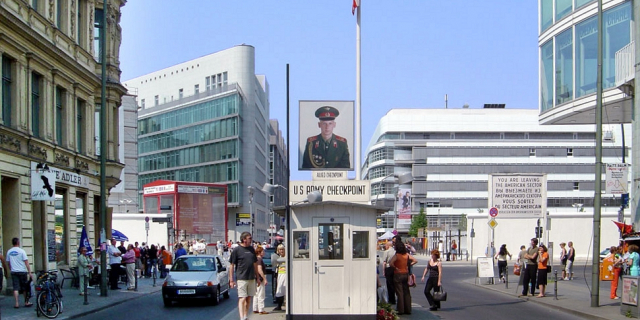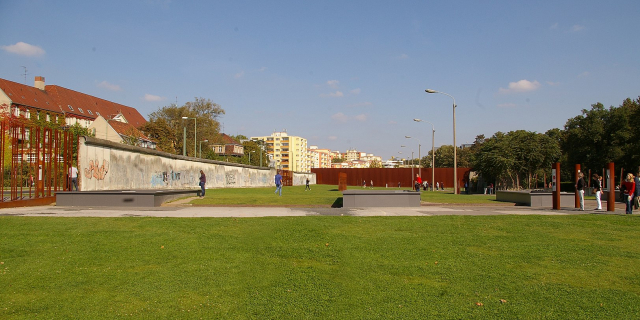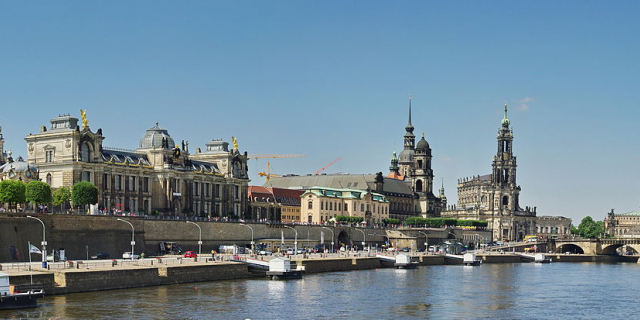Berlin
Context of Berlin
Berlin ( bur-LIN, German: [bɛʁˈliːn] (listen)) is the capital and largest city of Germany by both area and population. Its more than 3.85 million inhabitants make it the European Union's most populous city, according to population within city limits. One of Germany's sixteen constituent states, Berlin is surrounded by the State of Brandenburg and contiguous with Potsdam, Brandenburg's capital. Berlin's urban area, which has a population of around 4.5 million, is the second most populous urban area in Germany after the Ruhr. The Berlin-Brandenburg capital region has around 6.2 million inhabitants and is Germany's third-largest metropolitan region after the Rhine-Ruhr and Rhine-...Read more
Berlin ( bur-LIN, German: [bɛʁˈliːn] (listen)) is the capital and largest city of Germany by both area and population. Its more than 3.85 million inhabitants make it the European Union's most populous city, according to population within city limits. One of Germany's sixteen constituent states, Berlin is surrounded by the State of Brandenburg and contiguous with Potsdam, Brandenburg's capital. Berlin's urban area, which has a population of around 4.5 million, is the second most populous urban area in Germany after the Ruhr. The Berlin-Brandenburg capital region has around 6.2 million inhabitants and is Germany's third-largest metropolitan region after the Rhine-Ruhr and Rhine-Main regions.
Berlin straddles the banks of the Spree, which flows into the Havel (a tributary of the Elbe) in the western borough of Spandau. Among the city's main topographical features are the many lakes in the western and southeastern boroughs formed by the Spree, Havel and Dahme, the largest of which is Lake Müggelsee. Due to its location in the European Plain, Berlin is influenced by a temperate seasonal climate. About one-third of the city's area is composed of forests, parks, gardens, rivers, canals, and lakes. The city lies in the Central German dialect area, the Berlin dialect being spoken.
First documented in the 13th century and at the crossing of two important historic trade routes, Berlin became the capital of the Margraviate of Brandenburg (1417–1701), Kingdom of Prussia (1701–1918), German Empire (1871–1918), Weimar Republic (1919–1933), and Nazi Germany (1933–1945). Berlin has served as a scientific, artistic and philosophical hub of the Enlightenment, Neoclassicism, and liberal revolution. The Gründerzeit era's industrialization-induced economic boom multiplied Berlin's population rapidly. Berlin in the roaring 1920s was the third-largest city in the world by population.
After World War II and its subsequent occupation by the victorious countries, the devastated city was divided; West Berlin became a de facto exclave of West Germany, surrounded by the Berlin Wall (from August 1961 to November 1989) and East German territory. East Berlin was declared capital of East Germany, while Bonn became the West German capital. Following German reunification in 1990, Berlin once again became the capital of all of Germany.
Berlin is a world city of culture, politics, media and science. Its economy is based on high-tech firms and the service sector, encompassing a diverse range of creative industries, startup companies, research facilities, media corporations, and convention venues. Berlin serves as a continental hub for air and rail traffic and has a highly complex public transportation network. The metropolis is a popular tourist destination. Significant industries also include information technology, healthcare, biomedical engineering, biotechnology, automotive, construction, electronics, social economy and clean tech.
Berlin is home to world-renowned universities such as the Humboldt University, Technical University, Free University, University of the Arts, ESMT Berlin, Hertie School, and Bard College Berlin. Its Zoological Garden is the most visited zoo in Europe and one of the most popular worldwide. With Babelsberg being the world's first large-scale movie studio complex, Berlin is an increasingly popular location for international film productions. The city is well known for its festivals, diverse architecture, nightlife, contemporary arts, and high quality of life.
Berlin is also home to three World Heritage Sites: Museum Island; the Palaces and Parks of Potsdam and Berlin; and the Modernism Housing Estates. Other landmarks include the Brandenburg Gate, Reichstag building, Potsdamer Platz, Memorial to the Murdered Jews of Europe, Berlin Wall Memorial, East Side Gallery, Berlin Victory Column, Berlin Cathedral, and Berlin Television Tower, the tallest structure in Germany. Berlin has numerous museums, galleries, libraries, orchestras, and sporting events including Museum Island, the German Historical Museum, Jewish Museum, Natural History Museum, State Library, State Opera, Philharmonic, and the Berlin Marathon.
More about Berlin
- Population 3755251
- Area 891
- ...Read moreRead lessEtymologyHistorical affiliations
 Margraviate of Brandenburg 1237–1618
Margraviate of Brandenburg 1237–1618 Brandenburg-Prussia 1618–1701
Brandenburg-Prussia 1618–1701 Kingdom of Prussia 1701–1867
Kingdom of Prussia 1701–1867 North German Confederation 1867–1871
North German Confederation 1867–1871 German Empire 1871–1918
German Empire 1871–1918 Weimar Republic 1918–1933
Weimar Republic 1918–1933 Nazi Germany 1933–1945
Nazi Germany 1933–1945 Allied-occupied Germany 1945–1949
Allied-occupied Germany 1945–1949 West Germany 1949–1990
West Germany 1949–1990 East Germany 1949–1990
East Germany 1949–1990 Germany 1990–present
Germany 1990–presentBerlin lies in northeastern Germany, east of the River Elbe, that once constituted, together with the River (Saxon or Thuringian) Saale (from their confluence at Barby onwards), the eastern border of the Frankish Realm. While the Frankish Realm was primarily inhabited by Germanic tribes like the Franks and the Saxons, the regions east of the border rivers were inhabited by Slavic tribes. This is why most of the cities and villages in northeastern Germany bear Slavic-derived names (Germania Slavica). Typical Germanized place name suffixes of Slavic origin are -ow, -itz, -vitz, -witz, -itzsch and -in, prefixes are Windisch and Wendisch. The name Berlin has its roots in the language of West Slavic inhabitants of the area of today's Berlin, and may be related to the Old Polabian stem berl-/birl- ("swamp").[1] or Proto-Slavic bьrlogъ, (lair, den). Since the Ber- at the beginning sounds like the German word Bär ("bear"), a bear appears in the coat of arms of the city. It is therefore an example of canting arms.
Of Berlin's twelve boroughs, five bear a (partly) Slavic-derived name: Pankow (the most populous), Steglitz-Zehlendorf, Marzahn-Hellersdorf, Treptow-Köpenick and Spandau (named Spandow until 1878). Of its ninety-six neighborhoods, twenty-two bear a (partly) Slavic-derived name: Altglienicke, Alt-Treptow, Britz, Buch, Buckow, Gatow, Karow, Kladow, Köpenick, Lankwitz, Lübars, Malchow, Marzahn, Pankow, Prenzlauer Berg, Rudow, Schmöckwitz, Spandau, Stadtrandsiedlung Malchow, Steglitz, Tegel and Zehlendorf. The neighborhood of Moabit bears a French-derived name, and Französisch Buchholz is named after the Huguenots.
Prehistory of BerlinThe earliest human traces in the area of modern Berlin are dated around 60,000 BC.[2] A Mesolithic deer antler mask found in Biesdorf (Berlin) was dated around 9000 BC.[3] During Neolithic times a large number of communities existed in the area and in the Bronze Age up to 1000 people lived in 50 villages. Early Germanic tribes took settlement from 500 BC. Slavic settlements and castles began around 750 AD.[4]
12th to 16th centuries Map of Berlin in 1688
Map of Berlin in 1688 Berlin Cathedral (left) and Berlin Palace (right), 1900
Berlin Cathedral (left) and Berlin Palace (right), 1900The earliest evidence of middle age settlements in the area of today's Berlin are remnants of a house foundation dated to 1174, found in excavations in Berlin Mitte,[5] and a wooden beam dated from approximately 1192.[6] The first written records of towns in the area of present-day Berlin date from the late 12th century. Spandau is first mentioned in 1197 and Köpenick in 1209, although these areas did not join Berlin until 1920.[7] The central part of Berlin can be traced back to two towns. Cölln on the Fischerinsel is first mentioned in a 1237 document, and Berlin, across the Spree in what is now called the Nikolaiviertel, is referenced in a document from 1244.[6] 1237 is considered the founding date of the city.[8] The two towns over time formed close economic and social ties, and profited from the staple right on the two important trade routes Via Imperii and from Bruges to Novgorod.[9] In 1307, they formed an alliance with a common external policy, their internal administrations still being separated.[10][11]
In 1415, Frederick I became the elector of the Margraviate of Brandenburg, which he ruled until 1440.[12] During the 15th century, his successors established Berlin-Cölln as capital of the margraviate, and subsequent members of the Hohenzollern family ruled in Berlin until 1918, first as electors of Brandenburg, then as kings of Prussia, and eventually as German emperors. In 1443, Frederick II Irontooth started the construction of a new royal palace in the twin city Berlin-Cölln. The protests of the town citizens against the building culminated in 1448, in the "Berlin Indignation" ("Berliner Unwille").[13][14] This protest was not successful and the citizenry lost many of its political and economic privileges. After the royal palace was finished in 1451, it gradually came into use. From 1470, with the new elector Albrecht III Achilles, Berlin-Cölln became the new royal residence.[11] Officially, the Berlin-Cölln palace became permanent residence of the Brandenburg electors of the Hohenzollerns from 1486, when John Cicero came to power.[15] Berlin-Cölln, however, had to give up its status as a free Hanseatic city. In 1539, the electors and the city officially became Lutheran.[16]
17th to 19th centuriesThe Thirty Years' War between 1618 and 1648 devastated Berlin. One third of its houses were damaged or destroyed, and the city lost half of its population.[17] Frederick William, known as the "Great Elector", who had succeeded his father George William as ruler in 1640, initiated a policy of promoting immigration and religious tolerance.[18] With the Edict of Potsdam in 1685, Frederick William offered asylum to the French Huguenots.[19]
By 1700, approximately 30 percent of Berlin's residents were French, because of the Huguenot immigration.[20] Many other immigrants came from Bohemia, Poland, and Salzburg.[21]
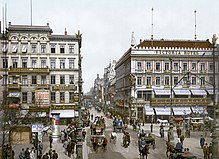 Berlin became the capital of the German Empire in 1871 and expanded rapidly in the following years.
Berlin became the capital of the German Empire in 1871 and expanded rapidly in the following years.Since 1618, the Margraviate of Brandenburg had been in personal union with the Duchy of Prussia. In 1701, the dual state formed the Kingdom of Prussia, as Frederick III, Elector of Brandenburg, crowned himself as king Frederick I in Prussia. Berlin became the capital of the new Kingdom,[22] replacing Königsberg. This was a successful attempt to centralise the capital in the very far-flung state, and it was the first time the city began to grow. In 1709, Berlin merged with the four cities of Cölln, Friedrichswerder, Friedrichstadt and Dorotheenstadt under the name Berlin, "Haupt- und Residenzstadt Berlin".[10]
In 1740, Frederick II, known as Frederick the Great (1740–1786), came to power.[23] Under the rule of Frederick II, Berlin became a center of the Enlightenment, but also, was briefly occupied during the Seven Years' War by the Russian army.[24] Following France's victory in the War of the Fourth Coalition, Napoleon Bonaparte marched into Berlin in 1806, but granted self-government to the city.[25] In 1815, the city became part of the new Province of Brandenburg.[26]
The Industrial Revolution transformed Berlin during the 19th century; the city's economy and population expanded dramatically, and it became the main railway hub and economic center of Germany. Additional suburbs soon developed and increased the area and population of Berlin. In 1861, neighboring suburbs including Wedding, Moabit and several others were incorporated into Berlin.[27] In 1871, Berlin became capital of the newly founded German Empire.[28] In 1881, it became a city district separate from Brandenburg.[29]
20th to 21st centuriesIn the early 20th century, Berlin had become a fertile ground for the German Expressionist movement.[30] In fields such as architecture, painting and cinema new forms of artistic styles were invented. At the end of the First World War in 1918, a republic was proclaimed by Philipp Scheidemann at the Reichstag building. In 1920, the Greater Berlin Act incorporated dozens of suburban cities, villages, and estates around Berlin into an expanded city. The act increased the area of Berlin from 66 to 883 km2 (25 to 341 sq mi). The population almost doubled, and Berlin had a population of around four million. During the Weimar era, Berlin underwent political unrest due to economic uncertainties but also became a renowned center of the Roaring Twenties. The metropolis experienced its heyday as a major world capital and was known for its leadership roles in science, technology, arts, the humanities, city planning, film, higher education, government, and industries. Albert Einstein rose to public prominence during his years in Berlin, being awarded the Nobel Prize for Physics in 1921.[citation needed]
In 1933, Adolf Hitler and the Nazi Party came to power. Hitler was inspired by the architecture he had experienced in Vienna, and he wished for a German Empire with a capital city that had a monumental ensemble. The National Socialist regime embarked on monumental construction projects in Berlin as a way to express their power and authority through architecture. Adolf Hitler and Albert Speer developed architectural concepts for the conversion of the city into World Capital Germania; these were never implemented.[31]
NSDAP rule diminished Berlin's Jewish community from 160,000 (one-third of all Jews in the country) to about 80,000 due to emigration between 1933 and 1939. After Kristallnacht in 1938, thousands of the city's Jews were imprisoned in the nearby Sachsenhausen concentration camp. Starting in early 1943, many were shipped to concentration camps, such as Auschwitz.[32]
Berlin hosted the 1936 Summer Olympics for which the Olympic stadium was built.[33]
 Berlin in ruins after World War II (Potsdamer Platz, 1945)
Berlin in ruins after World War II (Potsdamer Platz, 1945)During World War II, large parts of Berlin were destroyed during 1943–45 Allied air raids and the 1945 Battle of Berlin. The Allies dropped 67,607 tons of bombs on the city, destroying 6,427 acres of the built-up area. Around 125,000 civilians were killed.[34] After the end of World War II in Europe in May 1945, Berlin received large numbers of refugees from the Eastern provinces. The victorious powers divided the city into four sectors, analogous to Allied-occupied Germany the sectors of the Allies of World War II (the United States, the United Kingdom, and France) formed West Berlin, while the Soviet Union formed East Berlin.[35]
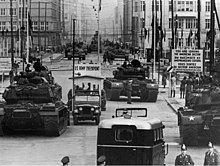 US and Soviet tanks face each other. Taken in 1961 at Checkpoint Charlie.
US and Soviet tanks face each other. Taken in 1961 at Checkpoint Charlie.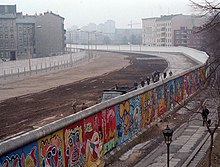 The Berlin Wall (painted on the western side) was a barrier that divided the city from 1961 to 1989.
The Berlin Wall (painted on the western side) was a barrier that divided the city from 1961 to 1989.All four Allies of World War II shared administrative responsibilities for Berlin. However, in 1948, when the Western Allies extended the currency reform in the Western zones of Germany to the three western sectors of Berlin, the Soviet Union imposed the Berlin Blockade on the access routes to and from West Berlin, which lay entirely inside Soviet-controlled territory. The Berlin airlift, conducted by the three western Allies, overcame this blockade by supplying food and other supplies to the city from June 1948 to May 1949.[36] In 1949, the Federal Republic of Germany was founded in West Germany and eventually included all of the American, British and French zones, excluding those three countries' zones in Berlin, while the Marxist–Leninist German Democratic Republic was proclaimed in East Germany. West Berlin officially remained an occupied city, but it politically was aligned with the Federal Republic of Germany despite West Berlin's geographic isolation. Airline service to West Berlin was granted only to American, British and French airlines.
 The fall of the Berlin Wall on 9 November 1989. On 3 October 1990, the German reunification process was formally finished.
The fall of the Berlin Wall on 9 November 1989. On 3 October 1990, the German reunification process was formally finished.The founding of the two German states increased Cold War tensions. West Berlin was surrounded by East German territory, and East Germany proclaimed the Eastern part as its capital, a move the western powers did not recognize. East Berlin included most of the city's historic center. The West German government established itself in Bonn.[37] In 1961, East Germany began to build the Berlin Wall around West Berlin, and events escalated to a tank standoff at Checkpoint Charlie. West Berlin was now de facto a part of West Germany with a unique legal status, while East Berlin was de facto a part of East Germany. John F. Kennedy gave his "Ich bin ein Berliner" speech on 26 June 1963, in front of the Schöneberg city hall, located in the city's western part, underlining the US support for West Berlin.[38] Berlin was completely divided. Although it was possible for Westerners to pass to the other side through strictly controlled checkpoints, for most Easterners, travel to West Berlin or West Germany was prohibited by the government of East Germany. In 1971, a Four-Power agreement guaranteed access to and from West Berlin by car or train through East Germany.[39]
In 1989, with the end of the Cold War and pressure from the East German population, the Berlin Wall fell on 9 November and was subsequently mostly demolished. Today, the East Side Gallery preserves a large portion of the wall. On 3 October 1990, the two parts of Germany were reunified as the Federal Republic of Germany, and Berlin again became a reunified city.[40] Walter Momper, the mayor of West Berlin, became the first mayor of the reunified city in the interim. City-wide elections in December 1990 resulted in the first "all Berlin" mayor being elected to take office in January 1991, with the separate offices of mayors in East and West Berlin expiring by that time, and Eberhard Diepgen (a former mayor of West Berlin) became the first elected mayor of a reunited Berlin.[41] On 18 June 1994, soldiers from the United States, France and Britain marched in a parade which was part of the ceremonies to mark the withdrawal of allied occupation troops allowing a reunified Berlin[42] (the last Russian troops departed on 31 August, while the final departure of Western Allies forces was on 8 September 1994). On 20 June 1991, the Bundestag (German Parliament) voted to move the seat of the German capital from Bonn to Berlin, which was completed in 1999, during the chancellorship of Gerhard Schröder.
 The rebuilt Berlin Palace in 2022
The rebuilt Berlin Palace in 2022Berlin's 2001 administrative reform merged several boroughs, reducing their number from 23 to 12.
In 2006, the FIFA World Cup Final was held in Berlin.
In a 2016 terrorist attack linked to ISIL, a truck was deliberately driven into a Christmas market next to the Kaiser Wilhelm Memorial Church, leaving 13 people dead and 55 others injured.[43][44]
In 2018, more than 200,000 protestors took to the streets in Berlin with demonstrations of racism for solidarity against the emergence of far-right politics in Germany.
Berlin Brandenburg Airport (BER) opened in 2020, nine years later than planned, with Terminal 1 coming into service at the end of October, and flights to and from Tegel Airport ending in November.[45] Due to the fall in passenger numbers resulting from the COVID-19 pandemic, plans were announced to temporarily close BER's Terminal 5, the former Schönefeld Airport, beginning in March 2021 for up to one year.[46] The connecting link of U-Bahn line U5 from Alexanderplatz to Hauptbahnhof, along with the new stations Rotes Rathaus and Unter den Linden, opened on 4 December 2020, with the Museumsinsel U-Bahn station expected to open around March 2021, which would complete all new works on the U5.[47] A partial opening by the end of 2020 of the Humboldt Forum museum, housed in the reconstructed Berlin Palace, which had been announced in June, was postponed until March 2021.[48]
Berlin-Brandenburg fusion attempt The coat of arms proposed in the state contract
The coat of arms proposed in the state contractThe legal basis for a combined state of Berlin and Brandenburg is different from other state fusion proposals. Normally, Article 29 of the Basic Law stipulates that a state fusion requires a federal law.[49] However, a clause added to the Basic Law in 1994, Article 118a, allows Berlin and Brandenburg to unify without federal approval, requiring a referendum and a ratification by both state parliaments.[50]
In 1996, there was an unsuccessful attempt of unifying the states of Berlin and Brandenburg.[51] Both share a common history, dialect and culture and in 2020, there are over 225.000 residents of Brandenburg that commute to Berlin. The fusion had the near-unanimous support by a broad coalition of both state governments, political parties, media, business associations, trade unions and churches.[52] Though Berlin voted in favor by a small margin, largely based on support in former West Berlin, Brandenburg voters disapproved of the fusion by a large margin. It failed largely due to Brandenburg voters not wanting to take on Berlin's large and growing public debt and fearing losing identity and influence to the capital.[51]
^ Berger, Dieter (1999). Geographische Namen in Deutschland. Bibliographisches Institut. ISBN 978-3-411-06252-2. ^ "Die Geschichte Berlins: Zeittafel & Fakten". 11 May 2022. ^ "Sammlung Online". ^ "Slawische Burganlagen in Deutschland". ^ "Berlin ist älter als gedacht: Hausreste aus dem Jahr 1174 entdeckt" [Berlin is older than thought: house remains from 1174 have been found] (in German). dpa. Archived from the original on 24 August 2012. Retrieved 24 August 2012. ^ a b Rising, David (30 January 2008). "Berlin dig finds city older than thought". NBC News. Associated Press. Archived from the original on 2 January 2018. Retrieved 1 January 2018. ^ "Zitadelle Spandau" [Spandau Citadel]. BerlinOnline Stadtportal GmbH & Co. KG. 2002. Archived from the original on 12 June 2008. Retrieved 18 August 2008. ^ "The medieval trading center". BerlinOnline Stadtportal GmbH & Co. KG. Archived from the original on 31 July 2016. Retrieved 11 June 2013. ^ Cite error: The named reference staple was invoked but never defined (see the help page). ^ a b Stöver B. Geschichte Berlins. Verlag CH Beck, 2010. ISBN 978-3-406-60067-8 ^ a b "Stadtgründung Und Frühe Stadtentwicklung" [City foundation and early urban development] (in German). Luisenstädtischer Bildungsverein. 2004. Archived from the original on 20 June 2013. Retrieved 10 November 2018. ^ "The Hohenzollern Dynasty". Antipas. 1993. Archived from the original on 7 August 2007. Retrieved 18 August 2008. ^ Komander, Gerhild H. M. (November 2004). "Berliner Unwillen" [Berlin unwillingness] (in German). Verein für die Geschichte Berlins e. V. Archived from the original on 19 September 2013. Retrieved 30 May 2013. ^ Conrad, Andreas (26 October 2012). "Was den "Berliner Unwillen" erregte" [What aroused the "Berlin unwillingness"]. Der Tagesspiegel (in German). Archived from the original on 8 October 2018. Retrieved 10 November 2018. ^ "The electors' residence". BerlinOnline Stadtportal GmbH & Co. KG. Archived from the original on 21 April 2017. Retrieved 11 June 2013. ^ "Berlin Cathedral". SMPProtein. Archived from the original on 18 August 2006. Retrieved 18 August 2008. ^ "Brandenburg during the 30 Years War". World History at KMLA. Archived from the original on 28 September 2008. Retrieved 18 August 2008. ^ Carlyle, Thomas (1853). Fraser's Magazine. J. Fraser. p. 63. Retrieved 11 February 2016. ^ Plaut, W. Gunther (1 January 1995). Asylum: A Moral Dilemma. Greenwood Publishing Group. p. 42. ISBN 978-0-275-95196-2. Archived from the original on 15 September 2015. Retrieved 20 June 2015. ^ Gray, Jeremy (2007). Germany. Lonely Planet. p. 49. ISBN 978-1-74059-988-7. Archived from the original on 15 September 2015. Retrieved 20 June 2015. ^ Cybriwsky, Roman Adrian (23 May 2013). Capital Cities around the World: An Encyclopedia of Geography, History, and Culture: An Encyclopedia of Geography, History, and Culture. ABC-CLIO. p. 48. ISBN 978-1-61069-248-9. Archived from the original on 15 September 2015. Retrieved 20 June 2015. ^ Horlemann, Bernd (Hrsg.), Mende, Hans-Jürgen (Hrsg.): Berlin 1994. Taschenkalender. Edition Luisenstadt Berlin, Nr. 01280. ^ Zaide, Gregorio F. (1965). World History. Rex Bookstore, Inc. p. 273. ISBN 978-971-23-1472-8. Archived from the original on 15 September 2015. Retrieved 20 June 2015. ^ Perry, Marvin; Chase, Myrna; Jacob, James; Jacob, Margaret; Von Laue, Theodore (1 January 2012). Western Civilization: Ideas, Politics, and Society. Cengage Learning. p. 444. ISBN 978-1-133-70864-3. Archived from the original on 14 September 2015. Retrieved 20 June 2015. ^ Lewis, Peter B. (15 February 2013). Arthur Schopenhauer. Reaktion Books. p. 57. ISBN 978-1-78023-069-6. Archived from the original on 14 September 2015. Retrieved 20 June 2015. ^ Harvard Student Agencies Inc. Staff; Harvard Student Agencies, Inc. (28 December 2010). Let's Go Berlin, Prague & Budapest: The Student Travel Guide. Avalon Travel. p. 83. ISBN 978-1-59880-914-5. Archived from the original on 14 September 2015. Retrieved 20 June 2015. ^ Andrea Schulte-Peevers (15 September 2010). Lonel Berlin. Lonely Planet. p. 25. ISBN 978-1-74220-407-9. Archived from the original on 15 September 2015. Retrieved 20 June 2015. ^ Stöver, Bernd (2 October 2013). Berlin: A Short History. C.H.Beck. p. 20. ISBN 978-3-406-65633-0. Archived from the original on 15 September 2015. Retrieved 20 June 2015. ^ Strassmann, W. Paul (15 June 2008). The Strassmanns: Science, Politics and Migration in Turbulent Times (1793–1993). Berghahn Books. p. 26. ISBN 978-1-84545-416-6. Archived from the original on 10 September 2015. Retrieved 20 June 2015. ^ Jack Holland; John Gawthrop (2001). The Rough Guide to Berlin. Rough Guides. p. 361. ISBN 978-1-85828-682-2. ^ Donath, Matthias (2006). Architecture in Berlin 1933–1945: A Guide Through Nazi Berlin. Germany: Lukas Verlag. p. 7. ISBN 9783936872934. ^ "The Jewish Community of Berlin". Holocaust Encyclopedia. Archived from the original on 8 July 2017. Retrieved 10 November 2018. ^ 1936 Summer Olympics official report. Archived 25 June 2008 at the Wayback Machine Volume 1. pp. 141–9, 154–62. Accessed 17 October 2010. ^ Micheal Clodfelter (2002), Warfare and Armed Conflicts- A Statistical Reference to Casualty and Other Figures, 1500–2000 (2nd ed.), McFarland & Company, ISBN 9780786412044 ^ Prof. Dr. Wolfgang Benz (27 April 2005). "Berlin - auf dem Weg zur geteilten Stadt" [Berlin – on the way to a divided city] (in German). Bundeszentrale für politische Bildung. Archived from the original on 10 November 2018. Retrieved 10 November 2018. ^ "Berlin Airlift / Blockade". Western Allies Berlin. Archived from the original on 18 March 2015. Retrieved 18 August 2008. ^ "Berlin after 1945". BerlinOnline Stadtportal GmbH & Co. KG. Archived from the original on 12 April 2009. Retrieved 8 April 2009. ^ Andreas Daum, Kennedy in Berlin. New York: Cambridge University Press, 2008, ISBN 978-0-521-85824-3, pp. 125‒56, 223‒26. ^ "Ostpolitik: The Quadripartite Agreement of September 3, 1971". U.S. Diplomatic Mission to Germany. 1996. Archived from the original on 25 February 2021. Retrieved 18 August 2008. ^ Berlin ‒ Washington, 1800‒2000: Capital Cities, Cultural Representation, and National Identities, ed. Andreas Daum and Christof Mauch. New York: Cambridge University Press, 2006, 23‒27. ^ "Berlin Mayoral Contest Has Many Uncertainties". The New York Times. 1 December 1990. Archived from the original on 17 June 2019. Retrieved 17 June 2019. ^ Kinzer, Stephan (19 June 1994). "Allied Soldiers March to Say Farewell to Berlin". The New York Times. New York City. Archived from the original on 21 November 2015. Retrieved 20 November 2015. ^ "IS reklamiert Attacke auf Weihnachtsmarkt für sich" [IS recalls attack on Christmas market for itself]. Frankfurter Allgemeine Zeitung (in German). 20 December 2016. Archived from the original on 21 March 2019. Retrieved 10 November 2018. ^ "Berlin attack: First aider dies 5 years after Christmas market murders". BBC. 26 October 2021. Archived from the original on 26 October 2021. Retrieved 26 October 2021. ^ Gardner, Nicky; Kries, Susanne (8 November 2020). "Berlin's Tegel airport: A love letter as it prepares to close". The Independent (in German). Archived from the original on 5 February 2021. Retrieved 5 February 2021. ^ Jacobs, Stefan (29 January 2021). "BER schließt Terminal in Schönefeld am 23. Februar" [BER closes the terminal in Schönefeld on February 23]. Der Tagesspiegel (in German). Archived from the original on 5 February 2021. Retrieved 5 February 2021. ^ "BVG will verlängerte U5 am 4. Dezember eröffnen" [BVG wants to open the extended U5 on December 4th]. rbb24 (in German). 24 August 2020. Archived from the original on 5 February 2021. Retrieved 5 February 2021. ^ "Humboldt Forum will zunächst nur digital eröffnen" [Humboldt Forum will initially only open digitally]. Der Tagesspiegel (in German). 27 November 2020. Archived from the original on 5 February 2021. Retrieved 5 February 2021. ^ "Grundgesetz für die Bundesrepublik Deutschland" [Basic Law for the Federal Republic of Germany]. Article 29, of 24 May 1949 (in German). Parlamentarischer Rat. ^ "Grundgesetz für die Bundesrepublik Deutschland" [Basic Law for the Federal Republic of Germany]. Einzelnorm 118a, of 27 October 1994 (in German). Bundestag. ^ a b "LÄNDERFUSION / FUSIONSVERTRAG (1995)". 2004. Retrieved 31 March 2022. ^ "Die Brandenburger wollen keine Berliner Verhältnisse". Tagesspiegel (in German). 4 May 2016. Retrieved 30 March 2022.
- Stay safe
Berlin might be a safe place, but it is a huge city, and as such has some not-so-well maintained areas. No specific rules apply with the exception of public transportation and tourist areas where pickpockets are a problem. Watch your bags during rush hours, at larger train stations (with the central, Warschauer, and Revaler stations being notoriously sketchy at night).
The police in Berlin are competent, not corrupt; therefore, if you try to bribe them you are likely to spend at least a night behind bars to check your background. They are generally helpful to tourists. Most of the officers are able to speak English, so don't hesitate to approach them if you are frightened or lost. Police are generally more relaxed than in more conservative places like Munich and do not necessarily engage in a "zero tolerance" policy (but even then blatantly smoking a joint in front of police will land you in trouble even in Berlin). In general police will focus on crime and traffic safety rather than petty misdemeanors or drunken tourists unless things get out of hand.
The nationwide emergency numbers are
Medical emergencies and fires, ☏ 112. Police emergency number, ☏ 110.Since the 1980s, there have been localised riots on Labour Day (May 1). In general they take place in Kreuzberg around Oranienstraße/Mariannenplatz. Nowadays they usually start the night before May 1, especially in the Mauerpark (Prenzlauer Berg), at Boxhagener Platz and in Rigaer Str. (Friedrichshain) and start again in the evening of May 1 in Kreuzberg and in the mentioned areas. The violent riots have become rather small since 2005 due to the engagement of the citizens who celebrate the Labour Day with a nice "myfest" in Kreuzberg and well-planned police efforts. It is still better to stay out of these areas from 20:00 until sunrise. Vehicles should not be parked in these area as this is asking for damage!
Racially-motivated violence is rare but the risk is higher on the outskirts of East Berlin. It is recommended for non-white tourists to be attentive in areas such as Lichtenberg, Hellersdorf, Marzahn, Treptow and Köpenick in the evening/night especially if alone.
...Read moreStay safeRead lessBerlin might be a safe place, but it is a huge city, and as such has some not-so-well maintained areas. No specific rules apply with the exception of public transportation and tourist areas where pickpockets are a problem. Watch your bags during rush hours, at larger train stations (with the central, Warschauer, and Revaler stations being notoriously sketchy at night).
The police in Berlin are competent, not corrupt; therefore, if you try to bribe them you are likely to spend at least a night behind bars to check your background. They are generally helpful to tourists. Most of the officers are able to speak English, so don't hesitate to approach them if you are frightened or lost. Police are generally more relaxed than in more conservative places like Munich and do not necessarily engage in a "zero tolerance" policy (but even then blatantly smoking a joint in front of police will land you in trouble even in Berlin). In general police will focus on crime and traffic safety rather than petty misdemeanors or drunken tourists unless things get out of hand.
The nationwide emergency numbers are
Medical emergencies and fires, ☏ 112. Police emergency number, ☏ 110.Since the 1980s, there have been localised riots on Labour Day (May 1). In general they take place in Kreuzberg around Oranienstraße/Mariannenplatz. Nowadays they usually start the night before May 1, especially in the Mauerpark (Prenzlauer Berg), at Boxhagener Platz and in Rigaer Str. (Friedrichshain) and start again in the evening of May 1 in Kreuzberg and in the mentioned areas. The violent riots have become rather small since 2005 due to the engagement of the citizens who celebrate the Labour Day with a nice "myfest" in Kreuzberg and well-planned police efforts. It is still better to stay out of these areas from 20:00 until sunrise. Vehicles should not be parked in these area as this is asking for damage!
Racially-motivated violence is rare but the risk is higher on the outskirts of East Berlin. It is recommended for non-white tourists to be attentive in areas such as Lichtenberg, Hellersdorf, Marzahn, Treptow and Köpenick in the evening/night especially if alone.
In the bordering neighbourhood of the districts Neukölln and Kreuzberg (between Hermannplatz, Schönleinstraße to Kottbusser Tor) and Wedding (Moabit and Gesundbrunnen) the risk of falling victim to robberies and assaults is higher. Tourists should visit these areas with some caution during the night as a mixture of drunken party people and poor neighbourhoods might lead to trouble.
National media and conservative politicians like to make a huge story out of certain well known drug dealing hot spots. Areas such as Görlitzer Park are well known for all sorts of illicit substances being on offer, but if you don't sell or buy this shouldn't preoccupy you. Despite media portrayals to the contrary, police do frequently raid those places and try to catch drug dealers, but only a small handful are usually caught as they have developed certain measures to evade capture. Organized criminality does exist, but in general they try to focus on less violent activity in Germany and hardly ever target outsiders.
Although harmless, panhandlers have started to beg at local tourist spots such as Pariser Platz next to the Brandenburg Gate, Alexanderplatz and the Museuminsel. They are usually women accompanied by their daughters who ask if you speak English and say that they are from the new EU countries and trying to raise money to fly home. The story is false, so don't give them money, which would encourage further exploitation of the women and their kids. They also have a new tactic where they hand you a card telling their "story" and asking for money; beware that the children that they carry in their arms will search through your bags while you are reading the card. The best way to avoid this is simply to ignore them and not to respond when they ask you "Speak English?" If you feel scared, don't hesitate to contact the police, as they will help.
ProstitutionProstitution is a legal business in Germany. Berlin has no major red-light district though some big brothels have been built. Berlin has no restricted areas for prostitutes (called a "Sperrbezirk" in German) so the "apartments" or brothels are spread throughout the whole city. Oranienburger Straße in Mitte is infamous for its prostitutes at night. These women are a tourist attraction and the ladies focus only on tourists to request exorbitant prices.
The proximity to Eastern Europe, relaxed visa rules, and the illegal migrant community increases the number of prostitutes. Advertisements are in the tabloids and online. Human trafficking and illegal immigration is a problem; therefore, police raids do take place and close down illegal operations. Brothels and prostitutes must register just like any other businesses, or they will be prosecuted for tax evasion. In general, police officers are not interested in the clients (especially if you stay calm and don't try to argue) but you must have a photo ID (a photocopy of your passport is fine) with you. Otherwise, you might spend a night at the police station while your background gets checked.


















